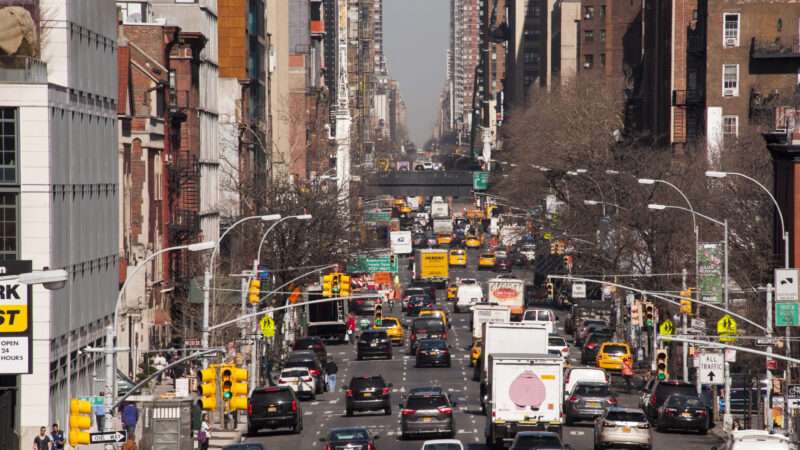
After a grueling, yearslong, process, New York area commuters finally know how much in new congestion charges they'll pay for driving into lower Manhattan. Actually getting the published tolls approved is going to require more process still.
Earlier this week, the board of the Metropolitan Transportation Authority (MTA)—the state agency that runs rail and bus service in the New York City area—gave initial approval to a toll schedule that will charge the average driver $15 to enter lower Manhattan during peak times (5 a.m. to 9 p.m. on weekdays and 9 a.m. to 9 p.m. on weekends).
Trucks, buses, and vans will pay $24 per day for the same privilege, while larger vehicles like multiunit trucks and sightseeing buses will pay $36 per day. Included in the schedule are discounts for low-income drivers and credits for people using already-tolled tunnels.
Vehicles without an E-ZPass will pay higher rates, ranging from $22.50 for passenger cars to $54 for larger trucks.
The revenue from these congestion tolls will go toward covering the MTA's budget deficits.
The board's vote this week merely kicks off an additional round of public input and review scheduled to last four months, during which more changes could be made. This latest stage of public review is in addition to the 19 outreach sessions the MTA held during the yearslong federal environmental review process. The agency has already received 28,000 pages worth of public comments as well.
So, congestion tolls won't be implemented until spring 2024 at the earliest.
New York's long road to congestion pricing started back in 2019 when the New York Legislature approved a plan to toll drivers entering lower Manhattan as part of that year's budget agreement.
The intent of the new tolls was to raise money for the city's cash-strapped subway system and reduce rush-hour gridlock. London, Singapore, and Stockholm all have tolled congestion zones covering their city centers.
Economics and transportation policy wonks tend to love congestion pricing as an efficient means of rationing scarce road space. Done right, it can be a real benefit to commuters who benefit from more predictable travel times and free-flowing traffic.
From the get-go, however, New York primarily pitched its congestion pricing plan as a means of raising money for the city's subway system. That helped alienate drivers who'd have to pay it.
"They didn't lead with, 'We're going to stabilize traffic flow and therefore benefit you as motorists,'" Marc Scribner, a transportation policy researcher at the Reason Foundation (which publishes this website), told Reason earlier this year. "You can understand the knee-jerk reaction from a lot of motorists is that this is a cash grab."
The political opposition from motorists has only complicated what was always going to be a fraught, prolonged implementation process.
Because New York was planning to toll federal highways leading into the city, the state needed federal sign-off, which in turn required it to perform federally mandated environmental studies.
Even figuring out what level of environmental analysis congestion pricing required, and then performing that analysis, took years. During that time, New York politicians accused the Trump administration of slow-walking the process for political reasons.
From the beginning, New Jersey politicians have tried to undermine the policy with federal legislation and, more recently, lawsuits contending New York didn't do all the necessary environmental studies on congestion pricing's effects.
These fees are considerably less than the $23 rush-hour fees transit officials had previously recommended, a fact New York Gov. Kathy Hochul was eager to highlight after the MTA board's vote.
"Congestion pricing means cleaner air, better transit and less gridlock on New York City's streets," Hochul said in a statement. "The proposal approved today heeds my call to lower the toll rate by nearly 35 percent from the maximum rate originally considered."
The reduced rates have done nothing to win over critics of congestion pricing.
"If you commute, want to see a doctor, or grab dinner in New York City, get ready to pay $40 to go over the GWB in 2024—in addition to gas and parking," said Rep. Josh Gottheimer (D–N.J.), factoring in tunnel tolls, potential "gridlock alert day" surcharges, and higher rates drivers without E-ZPass will have to pay. "The MTA is a hot mess and just desperate for cash."
New York City Mayor Eric Adams also raised concerns about the "two yellows"—school buses and taxis—which he said should pay lower fees.
Of course, the more people and vehicles that are exempt from congestion tolls, the less they'll end up doing to fight congestion. The same is true of lowering the tolls for everyone.
New York could potentially be walking into a situation where its tolls are still too high to appease New Jersey drivers but not so high as to fix Manhattan gridlock. In that scenario, the tolls would more or less be functioning as just another tax.
The post New York Will Charge Drivers $15 To Enter Lower Manhattan appeared first on Reason.com.







